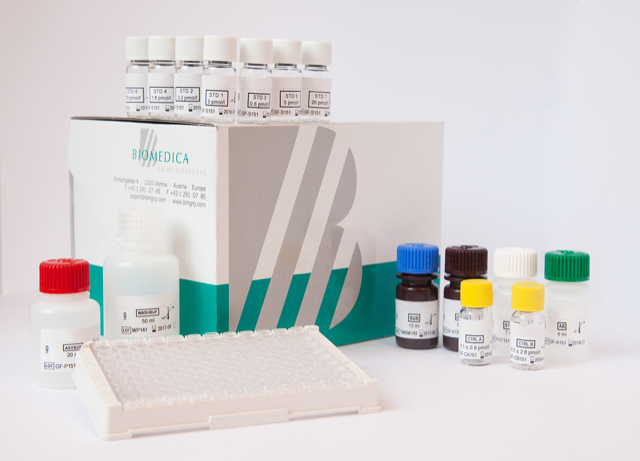Urine Vanin-1 ELISA Assay
The Urine Vanin-1 ELISA Assay is For Research Use Only
Product Developed and Manufactured in Austria by Biomedica
Size: 12×8
Sensitivity: 9.6 pmol/l
Standard Range: 9.6 – 1 200 pmol/l
Incubation Time: 4.5 hours
Sample Type: Urine
Sample Size: 10 µl / well
Controls Included
Conversion factor: 1 pg/ml = 0.0192 pmol/l (MW: 52.07 kDa)
Assay Background
Vanin-1 (VAN1) is a GPI-anchored glycoprotein of 513 amino acids consisting of a base domain and an enzymatic nitrilase domain (Boersma et al., 2014). The ectoenzyme catalyzes the hydrolysis of pantetheine to pantothenic acid (vitamin B5) and cyteamine and thus, is involved in the regulation of oxidative stress and inflammation (Maras et al., 1999). Vanin-1 has a broad tissue expression with the highest levels being observed in kidney tubular epithelial cells (Pitari et al., 2000). The GPI anchor of Vanin-1 can be cleaved by a yet unknown mechanism, resulting in Vanin-1 being shed into the extracellular space.
Function: Vanin-1 is an epithelial ectoenzyme activating the conversion of pantetheine into pantothenic acid (vitamin B5) and cysteamine (Pitari et al., 2000). It has been suggested that the release of cysteamine by Vanin-1 promotes oxidative tissue damage and inflammation by inhibiting the activity of antioxidants like superoxide dismutase (SOD) and glutathione (GSH) (Hosohata et al., 2011; Saghaei et al., 2012). Indeed, Vanin-1 knockout mice have elevated stores of GSH and are more resistant to oxidative injury induced by whole-body gamma irradiation (Berruyer et al., 2004). On the other hand, several reports indicate that Vanin-1 might also act as tissue sensor for oxidative stress. In mice, antioxidant response-like elements could be identified in the promotor region of Vanin-1, which enhance the expression of Vanin-1 in the presence of oxidative stress (Berruyer et al., 2004). Similarly, Vanin-1 expression was shown to be upregulated in a human proximal tubular cell line after exposure to organic solvents (Hosohata et al., 2011). After renal ischemia-reperfusion in rats, a model involving oxidative tissue damage, renal Vanin-1 expression was also found to be upregulated (Yoshida et al., 2002). The highest levels of Vanin-1 expression could be assigned to renal tubular epithelial cells, while no expression is detectable in glomeruli (Hosohata et al., 2011; Pitari et al., 2000). Hence, Vanin-1 released from renal cells could be detectable in urine. In a study aimed to identify biomarkers for renal tubular injury, Hosohata and colleagues could indeed show in a rat model of nephrotoxicant-induced injury that Vanin-1 is upregulated in renal tubules earlier than other markers and shed into urine (Hosohata et al., 2011). Subsequent studies further verified the validity of Vanin-1 as an early biomarker of renal tubular damage in drug-induced acute kidney injury (Hosohata et al., 2012, 2016a), obstructive nephropathy (Washino et al., 2019) and hydronephrosis (Hosohata et al., 2018), diabetic nephropathy (Fugmann et al., 2011), renal injury in experimental colitis (Hosohata et al., 2014) and spontaneously hypertensive rats under high salt intake (Hosohata et al., 2016b; Washino et al., 2018). Of note, Vanin-1 seems to have superior predictive value for acute kidney injury than established markers KIM-1, NGAL, or NAG.
Related Products
Vanin-1 Mouse/Rat ELISA Assay Kit
Bovine Alpha 1-Acid Glycoprotein ELISA


